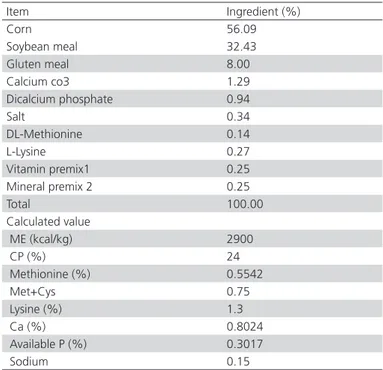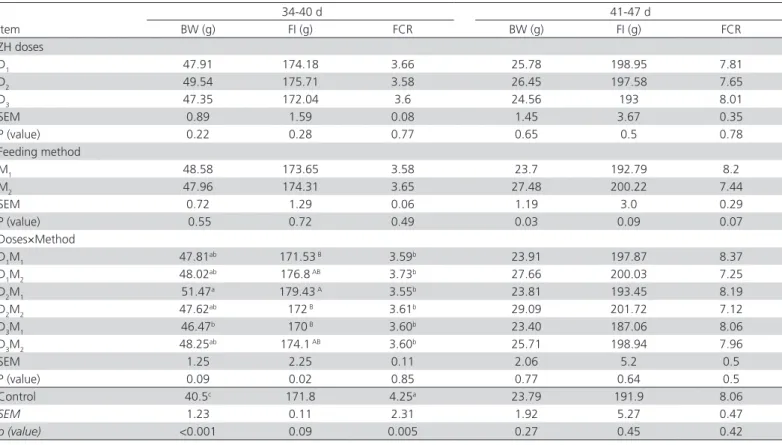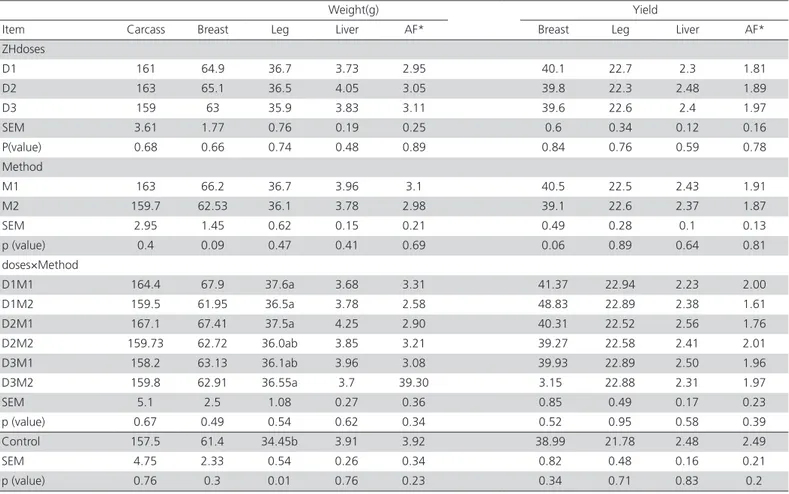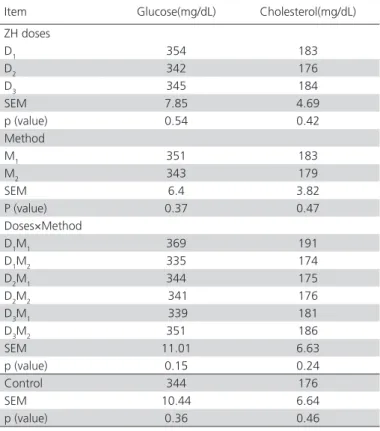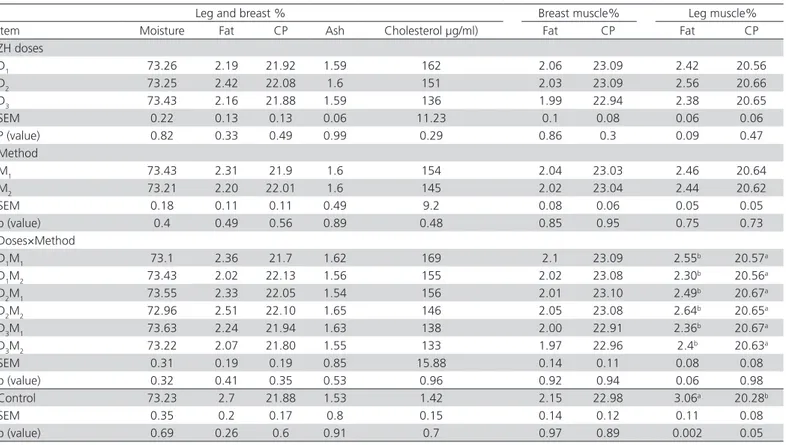http://dx.doi.org/10.1590/1516-635x1704567-574
During Two Weeks of the Finishing Period
Author(s)
Mohammadi-Arekhlo MI Towhidi AI
Moravej HI Sharafi MII
I Department of Animal Science, Faculty of Agricultural Science and Engineering, University of Tehran, Karaj.
II Department of Poultry Science, College of Agriculture, Tarbiat Modares University, Tehran.
Mail Address
Corresponding author e-mail address Mohsen Sharafi
Department of Poultry Science, College of Agriculture, Tarbiat Modares University, Tehran.
Ph: 00982148292348 Fax: 00982148292055 Email: m.sharafi@modares.ac.ir
Keywords
β-adrenergic agonists, body weight, meat quality, Japanese quails.
Submitted: August/2014 Approved: April/2015
ABSTRACT
The objective of this study was to determine the effects of different zilpaterol hydrochloride (ZH) levels and feeding methods on the growth performance and carcass traits of Japanese quails. In this trial, 224 male quails with 34 days of age were distributed into seven treatments. A factorial arrangement with three ZH levels (0.2, 0.225, and 0.25 mg zilpaterol/kg of live weight−1) × two feeding
methods (ZH supplementation daily or every two days) plus a control treatment (no ZH supplementation) was applied. The weight gain of birds fed ZH every two days was significantly higher than those fed ZH daily during the period of 41-47 days (p=0.03). During the period of 34-40 days, ZH-supplemented birds presented higher weight gain (p<0.001) and better feed conversion ratio (p=0.005) compared with the control group. Moisture, protein, ash, and cholesterol levels of the combination of breast and leg were not affected (p≥0.10) by zilpaterol supplementation. Leg muscle fat and protein contents of control birds were higher and lower compared with ZH-supplemented birds, respectively (p=0.002 and p=0.05). In conclusion, ZH supplementation in the diet of male Japanese quail improved growth performance during the finishing period (34-40d), and the most economical level of ZH is 0.2 (mg/kg of LW−1 d−1), when supplemented every two days.
INTRODUCTION
daily gain of lambs during the first 6 weeks of rearing, whereas Pringle et al. (1993) found that L644,969, a type ofβ-AA, improved daily gain of lambs only during the first 2 weeks, and dressing percentage during the first 4 weeks of feeding.
In our literature review, we did not find any published data on the effect of ZH on the growth performance of avian species. Therefore, this study aimed at evaluating the effects of three dietary levels of ZH and two methods ZH feeding methods on the growth performance, carcass traits, and blood parameters of Japanese quails.
MATERIALS AND METHODS
Facilities and birds
One thousand Japanese quails (1 d old) were reared in a temperature-controlled room on the floor until 34 days of age. Then, 224 male Japanese quails with similar average of live body weight were randomly assigned to 28 battery cages according to a completely randomized block design with seven treatments and four replicates (cage) of eight birds per experimental unit. Room temperature was maintained at 36-38°C for the first 3 d, and was then reduced by 3°C weekly until reaching 23-24°C. Continuous light was provided.
Diets and experimental design
The finisher diet was were based on corn and soybean meal and its composition is shown in Table 1. Birds were fed diets with three different doses of zilpaterol (0.2 (D1), 0.225 (D2), or 0.25 (D3) mg zilpaterol/kg of live weight−1) for 14 days of the
finishing period by two methods: zilpaterol (M1) was fed daily or every two days (M2). A control group was established, in which the birds did not receive any ZH supplementation. Zilpaterol hydrochloride was withdrawn three days prior to slaughter.
Data collection
Body weight and feed intake were recorded at weekly intervals. At the end of the finishing period, when broilers were 50 days of age, birds were submitted to 12 h of feed withdrawal, eight birds (two birds which body weight was similar to the average in each replicate) per treatment were sacrificedby severing the right carotid artery and jugular vein. After bleeding, birds were processed and dissected by a trained team. The heads and necks were removed by cutting through the last cervical and the first thoracic vertebrae, and the shank at the tibiotarsal-metatarsal joints Vidyadaran et
al. (1988). Carcass dressing percentage was calculated as carcass weight (without blood, feathers, head, neck, shank, or giblets) relative to live weight. Liver, abdominal fat, legs, and breast were weighed and kept at -20 °C for chemical composition determination.
Carcass chemical analyses
Leg and breast chemical composition was determined as described by the AOAC (1990). The skin and the subcutaneous fat were removed. The muscles of the right breast and leg were carefully dissected, homogenized using a blender, and the analyzed for total moisture, ash, crude protein, crude fat, and cholesterol contents. The left breast and leg muscles were separately analyzed for crude protein and crude fat contents. In order to determine total cholesterol content of the muscles, tissue samples were thawed and extracted with 2:1 chloroform: methanol (Bligh & Deyer, 1959). Total cholesterol levels were then enzymatically determined by the method of Allain et al. (1974).
Blood samples collection and analysis
Individual blood samples were collected during bleeding, and immediately centrifuged at 3500 rpm for 15 min. Plasma was harvested after centrifugation of the clotted blood, stored at -20°cin a deep freezer until the time of chemical determinations. Blood biochemical parameters were enzymatically determined using commercial kits.
Table 1 – Ingredients and calculated composition of the basal diet (as-fed basis)
Item Ingredient (%)
Corn 56.09
Soybean meal 32.43
Gluten meal 8.00
Calcium co3 1.29
Dicalcium phosphate 0.94
Salt 0.34
DL-Methionine 0.14
L-Lysine 0.27
Vitamin premix1 0.25
Mineral premix 2 0.25
Total 100.00
Calculated value
ME (kcal/kg) 2900
CP (%) 24
Methionine (%) 0.5542
Met+Cys 0.75
Lysine (%) 1.3
Ca (%) 0.8024
Available P (%) 0.3017
Statistical analysis
At first, data of all treatments were analyzed without control group according to a completely randomized block design in a 3 (levels of ZH) × 2 (feeding method) factorial arrangement, using cages as blocks. At the second step, in order to compare the averages of the treatments with the control treatment, data were analyzed according to a randomized block design using the GLM procedure of SAS. Means were compared using Duncan’s test at significance level of p<0.05.
RESULTS AND DISCUSSION
The main effects of doses and methods (D & M) and their interactions on growth performance during the two last finishing weeks were shown in Table 2. Significant dose x method interactions were observed for feed intake during the period of days 34-40. The highest feed intake was obtained in group D2 x
M1.There were significant weight gain differences between M1 and M2when birds were fed zilpaterolon days 41-47 (p=0.03), with M2 birds presenting higher weight gain than M1 birds. In this regard, Moloney et al. (1991) stated that extended time of β-adrenergic use during the finishing period may cause β-adrenergic receptor desensitization and down regulation, thereby reducing growth rate responses. In addition, pig studies indicate that intermittent use of ractopamine may help reducing this negative effect on performance because of the resting time given to the receptors Dib
et al. (2010).It seems that in our trial, the M2 method
reduced the down regulation of the β-adrenergic receptor. In fact, we suppose that the higher weight gain obtained with the M2 method on days 41-47 may be due to the up regulation of the β-adrenergic receptor during the two days the product was not fed after two days of feeding. The effect of zilpaterol supplementation on the growth performance of the treated and control groups reshown in Table 2.
Table 2 – Main effects and interactions of doses and methods of zilpaterol supplementation on thebody weight (BW), feed intake (FI), and feed conversion ratio (FCR)ofJapanese quails and comparison with the control group.
34-40 d 41-47 d
Item BW (g) FI (g) FCR BW (g) FI (g) FCR
ZH doses
D1 47.91 174.18 3.66 25.78 198.95 7.81
D2 49.54 175.71 3.58 26.45 197.58 7.65
D3 47.35 172.04 3.6 24.56 193 8.01
SEM 0.89 1.59 0.08 1.45 3.67 0.35
P (value) 0.22 0.28 0.77 0.65 0.5 0.78
Feeding method
M1 48.58 173.65 3.58 23.7 192.79 8.2
M2 47.96 174.31 3.65 27.48 200.22 7.44
SEM 0.72 1.29 0.06 1.19 3.0 0.29
P (value) 0.55 0.72 0.49 0.03 0.09 0.07
Doses×Method
D1M1 47.81ab 171.53 B 3.59b 23.91 197.87 8.37
D1M2 48.02
ab 176.8 AB 3.73b 27.66 200.03 7.25
D2M1 51.47a 179.43 A 3.55b 23.81 193.45 8.19
D2M2 47.62
ab 172 B 3.61b 29.09 201.72 7.12
D3M1 46.47b 170 B 3.60b 23.40 187.06 8.06
D3M2 48.25
ab 174.1 AB 3.60b 25.71 198.94 7.96
SEM 1.25 2.25 0.11 2.06 5.2 0.5
P (value) 0.09 0.02 0.85 0.77 0.64 0.5
Control 40.5c 171.8 4.25a 23.79 191.9 8.06
SEM 1.23 0.11 2.31 1.92 5.27 0.47
p (value) <0.001 0.09 0.005 0.27 0.45 0.42
D1, 2, 3: (0.2, 0.225, 0.25 mg/kg of LW−1 d−1 zilpaterol, respectively) M1: received zilpaterol daily; M2: received zilpaterol every two days Control: diet with no ZH supplementation
D1,2,3&M1,2,: effect of the interaction between D and M in the different treatments.
Zilpaterol supplementation improved weight gain (p=0.0003) and feed conversion ratio (p=0.005) in all treatments compared with the control group, but it did not affect feed intake on days 34-40 (p=0.09). However, on days 41-47 days, zilpaterol did not significantly affect growth performance. There are some reports about different effects of β-agonists on the growth performance of animals. Ansari-Pirsaraei
et al. (2007) demonstrated that terbutaline did not
affect daily weight gain, but reduced feed conversion ratio (FCR) of male broilers when5 and 10 mg/kg were fed, respectively. On the other hand, in some studies, ZH supplementation increased average daily gain and gain efficiency in feedlot lambs (Estrada-Angulo et al., 2008), steers (Avendano-Reyes et al., 2006) and cattle (Vasconcelos et al., 2008). However, Felix et al. (2005) did not observe any effect of ZH supplementation on
the growth performance of Pelibuey lambs. The reasons why no performance differences were observed on days 41-47 days between birds receiving ZH and the control group may be bird maturity and hormonal changes. Another reason for this phenomenon is that the ß-AA receptor in the target tissues may be rapidly inactivated, or a particular species may have a limited number of ß-AA receptors in the target tissues, reducing the response to the agonist (Mersmann, 1998). Perhaps the Japanese quail is one the species that has a limited number of receptors.
Table 3 shows that, when the zilpaterol supple-mented groups were compared, carcass traits were not influenced by the treatments or their interactions. However, leg weight was higher in ZH-fed chickens (D1 and D2 of M1, D1 and D3 of M2) than in con-trol group (p=0.01), but the weights of the other parts
Table 3 – Main effects and interactions of doses and methods of zilpaterol supplementation on carcass and parts weight and yield of Japanese quails and comparison with the control group.
Weight(g) Yield
Item Carcass Breast Leg Liver AF* Breast Leg Liver AF*
ZHdoses
D1 161 64.9 36.7 3.73 2.95 40.1 22.7 2.3 1.81
D2 163 65.1 36.5 4.05 3.05 39.8 22.3 2.48 1.89
D3 159 63 35.9 3.83 3.11 39.6 22.6 2.4 1.97
SEM 3.61 1.77 0.76 0.19 0.25 0.6 0.34 0.12 0.16
P(value) 0.68 0.66 0.74 0.48 0.89 0.84 0.76 0.59 0.78
Method
M1 163 66.2 36.7 3.96 3.1 40.5 22.5 2.43 1.91
M2 159.7 62.53 36.1 3.78 2.98 39.1 22.6 2.37 1.87
SEM 2.95 1.45 0.62 0.15 0.21 0.49 0.28 0.1 0.13
p (value) 0.4 0.09 0.47 0.41 0.69 0.06 0.89 0.64 0.81
doses×Method
D1M1 164.4 67.9 37.6a 3.68 3.31 41.37 22.94 2.23 2.00
D1M2 159.5 61.95 36.5a 3.78 2.58 48.83 22.89 2.38 1.61
D2M1 167.1 67.41 37.5a 4.25 2.90 40.31 22.52 2.56 1.76
D2M2 159.73 62.72 36.0ab 3.85 3.21 39.27 22.58 2.41 2.01
D3M1 158.2 63.13 36.1ab 3.96 3.08 39.93 22.89 2.50 1.96
D3M2 159.8 62.91 36.55a 3.7 39.30 3.15 22.88 2.31 1.97
SEM 5.1 2.5 1.08 0.27 0.36 0.85 0.49 0.17 0.23
p (value) 0.67 0.49 0.54 0.62 0.34 0.52 0.95 0.58 0.39
Control 157.5 61.4 34.45b 3.91 3.92 38.99 21.78 2.48 2.49
SEM 4.75 2.33 0.54 0.26 0.34 0.82 0.48 0.16 0.21
p (value) 0.76 0.3 0.01 0.76 0.23 0.34 0.71 0.83 0.2
D1, 2, 3: (0.2, 0.225, 0.25 mg/kg of LW−1 d−1 zilpaterol, respectively) M1: received zilpaterol daily; M2: received zilpaterol every two days Control: diet with no ZH supplementation
D1,2,3&M1,2,: effect of the interaction between D and M in the different treatments.
abc Means in the same column without a common superscript letter are different when groups receiving ZH were compared with the control group (p< 0.05).
were not significantly different (p>0.05). This finding is in agreement with the results of Morgan et al. (1989), which obtained heavier legs in chickens fed with ci-materol. However, in some cases, β-agonist supple-mentation did not affect carcass weight or dressing percentage (Koohmaraie et al., 1991). This disparity in responses may be due to the fact that a given agonist may not activate the target tissue receptors as well in one species as in another. The possible mechanisms include agonist affinity for the receptor(s), coupling of the agonist-receptor complex to the signal transduc-tion system, and factors that influence delivery of the compound to the receptor sites (Mersmann, 1998).
In this study, plasma glucose and cholesterol levels were not influenced (p<0.05) by the administration of β-AA (Table 4). These results are consistent with the previous report of Lopez-Carlos et al. (2010), but opposed to those found by Ansari-Pirsaraei et al. (2007). Plasma cholesterol decreased in chickens treated with
dopamine in another experiment (Buyse et al., 1991). Responses to various ß-AA vary with age, species, sex, diet, breed, dose and duration of treatment, which may be due to stimulation of different receptors (Beermann, 2002).
Table 5 shows the main effects and interactions between doses and methods of zilpaterol supplementation on the composition of breast and leg muscle in Japanese quails. There were no significant differences among ZH-supplementation treatments. However, as seen in Table 5, the fat and protein contents of the leg muscle in control group were higher and lower compared with the ZH treatments, respectively (p=0.002 and p=0.05). This finding is in agreement with the results of Morgan et al. (1989) with broiler chickens treated by cimaterol. Zilpaterol may affect muscle fat content by two mechanisms. The first is related with the activation of β-adrenergic receptors, resulting in an increase in the number of cAMP and higher lipolysis rate in the fat tissue, thereby reducing muscle fat content. The second mechanism is related with the phosphorylation of protein kinase A and then deactivation of acetyl COA carboxylase, reducing lipogenesis rate. On the other hand, ZH may increase muscle protein content by increasing the biosynthesis of intracellular protein. Watson-Wright & Wilkinson(1986)reported that skeletal muscle has beta-2 subclass receptors, but that receptor density is a function of muscle type. White fibers appear to have low beta-receptor density, whereas red fibers contain high beta-receptor density. The lack of response in the breast muscle to ZH treatment in the present experiment could be partially due to the higher proportion of white fibers in the breast muscle relative to leg muscle. The percentage of moisture, protein, ash, and cholesterol in the breast and leg muscles were not affected (p≥0.10) by zilpaterol. Out results are consistent with those of Dawson et al. (1997), who supplemented beef steers with other β-AA and did not find any effects on carcass ash percentage.
In conclusion, ZH supplementation in the diet of male Japanese quail improved growth performance during the finishing period (34-40d), and the most economical level of ZH is 0.2 (mg/kg of LW−1 d−1), when
supplemented every two days.
ACKNOWLEDGMENTS
The authors express their gratitude to University of Tehran for providing the equipment and facilities to perform this trial.
Table 4 – Main effects and interactions of doses and methods of zilpaterol supplementation on blood parameters of Japanese quails and comparison with the control group.
Item Glucose(mg/dL) Cholesterol(mg/dL)
ZH doses
D1 354 183
D2 342 176
D3 345 184
SEM 7.85 4.69
p (value) 0.54 0.42
Method
M1 351 183
M2 343 179
SEM 6.4 3.82
P (value) 0.37 0.47
Doses×Method
D1M1 369 191
D1M2 335 174
D2M1 344 175
D2M2 341 176
D3M1 339 181
D3M2 351 186
SEM 11.01 6.63
p (value) 0.15 0.24
Control 344 176
SEM 10.44 6.64
p (value) 0.36 0.46
D1, 2, 3: (0.2, 0.225, 0.25 mg/kg of LW−1 d−1 zilpaterol, respectively) M1: received zilpaterol daily; M2: received zilpaterol every two days Control: diet with no ZH supplementation
REFERENCES
Allain CC, Poon LS, Chan CSG, Richmond W, Fu PC. Enzymatic determination of total serum cholesterol. Clinical Chemistry 1974;20:470-475.
Allen JD, Ahola JK, Chahine M, Szasz JI, Hunt CW, Schneider CS, et al. Effect of pre slaughter feeding and ractopamine hydrochloride supplementation on growth performance, carcass characteristics, and end product quality in market dairy cows. Journal of Animal Science 2009;87:2400-2408.
Ansari-pirsaraei Z, Abolghasemi AH, Jafari-Sayadi AR, Jalali-Hajiabadi MA. Effect of terbutaline feeding on some blood parameters and carcass characteristics in broiler chicks. Proceedings of the 16th European Symposium on Poultry Nutrition;2007; Strasbourg. France. p. 483-486.
Apple JK, Maxwell CV, Kutz BR, Rakes LK, Sawyer JT, Johnson ZB, Armstrong TA, Carr, SN, Matzat PD. Interactive effect of ractopamine and dietary fat source on pork quality characteristics of fresh pork chops during simulated retail display. Journal of Animal Science 2008;86:2711-2722.
AOAC. Official Methods of analysis association of Official Analytical Chemists. Arlington; 1990.
Avendano-Reyes L, Torress-Rodriguez V, Meraz-Murillo FJ, Perez-Linares C, Figueroa-Saavedra F, Robinson PH. Effects of two beta-adrenergic agonists on finishing performance, carcass characteristics, and meat quality of feedlot steers. Journal of Animal Science 2006;84:3259-3265.
Beermann, DH. Beta-Adrenergic receptor agonist modula-tion of skeletal muscle growth. Journal of Animal Science 2002;80:(E. suppl. 1):E18-E23.
Bligh EG, Dyer WJ. A rapid method of total lipid extraction and purification. Canadian Journal of Biochemistry and Physiology 1959;.37:911-917.
Buyse J, Decuypere E, Huyghebaert G, Herremans M. The effect of clenbuterol supplementation on growth performance and plasma hormone and metabolite levels of broilers. Poultry Science 1991;70:993-1002.
Carr SN, Ivers J, Anderson DB, Jones DJ, Mowrey DH, England MB, et al. The effects of ractopamine hydrochloride on lean carcass yields and pork quality characteristics. Journal of Animal Science 2005;83:2886-2893.
Dawson JM, Soar JB, Buttery PJ, Craigon J, Gill M, Beever DE. The effect of immunization against somatostatin and β-agonist administration alone and in combination on growth and carcass composition in young steers. Journal of Animal Science 1997;64:37-57.
Dib MG. Strategies for beef cattle adaptation to finishing diets, Ractopamine hydrochloride utilization and mature size genetic selection. [thesis]. University of Nebraska; 2010.
Estrada-Angulo A, Barreras-Serrano A, Contreras G, Obregon JF, Robles-Estrada JC, Plascencia A, et al. Influence of level of zilpaterol hydrochloride supplementation on growth performance and carcass characteristics of feedlot lambs. Small Ruminant Research 2008;80:107-110.
Table 5 – Main effects and interactions of doses and methods of zilpaterol supplementation on muscle composition (%) of Japanese quails and comparison with the control group.
Leg and breast % Breast muscle% Leg muscle%
Item Moisture Fat CP Ash Cholesterol µg/ml) Fat CP Fat CP
ZH doses
D1 73.26 2.19 21.92 1.59 162 2.06 23.09 2.42 20.56
D2 73.25 2.42 22.08 1.6 151 2.03 23.09 2.56 20.66
D3 73.43 2.16 21.88 1.59 136 1.99 22.94 2.38 20.65
SEM 0.22 0.13 0.13 0.06 11.23 0.1 0.08 0.06 0.06
P (value) 0.82 0.33 0.49 0.99 0.29 0.86 0.3 0.09 0.47
Method
M1 73.43 2.31 21.9 1.6 154 2.04 23.03 2.46 20.64
M2 73.21 2.20 22.01 1.6 145 2.02 23.04 2.44 20.62
SEM 0.18 0.11 0.11 0.49 9.2 0.08 0.06 0.05 0.05
p (value) 0.4 0.49 0.56 0.89 0.48 0.85 0.95 0.75 0.73
Doses×Method
D1M1 73.1 2.36 21.7 1.62 169 2.1 23.09 2.55b 20.57a
D1M2 73.43 2.02 22.13 1.56 155 2.02 23.08 2.30b 20.56a
D2M1 73.55 2.33 22.05 1.54 156 2.01 23.10 2.49b 20.67a
D2M2 72.96 2.51 22.10 1.65 146 2.05 23.08 2.64
b 20.65a
D3M1 73.63 2.24 21.94 1.63 138 2.00 22.91 2.36b 20.67a
D3M2 73.22 2.07 21.80 1.55 133 1.97 22.96 2.4
b 20.63a
SEM 0.31 0.19 0.19 0.85 15.88 0.14 0.11 0.08 0.08
p (value) 0.32 0.41 0.35 0.53 0.96 0.92 0.94 0.06 0.98
Control 73.23 2.7 21.88 1.53 1.42 2.15 22.98 3.06a 20.28b
SEM 0.35 0.2 0.17 0.8 0.15 0.14 0.12 0.11 0.08
p (value) 0.69 0.26 0.6 0.91 0.7 0.97 0.89 0.002 0.05
D1, 2, 3: (0.2, 0.225, 0.25 mg/kg of LW−1 d−1 zilpaterol, respectively) M1: received zilpaterol daily; M2: received zilpaterol every two days Control: diet with no ZH supplementation
D1,2,3&M1,2,: effect of the interaction between D and M in the different treatments.
Felix A, Estrada-Angulo A, Rios FG, Ramos CH, Perez AB. Effect of Zilpaterol clorhidrate on growth performance and carcass traits in finishing sheep. Journal of Animal Science 2005;83:63-63.
Gruber SL, Tatum JD, Engle TE, Mitchell MA, Laudert SB, Schroeder AL, et al. Effects of ractopamine supplementation on growth performance and carcass characteristics of feedlot steers differing in biological type. Journal of Animal Science 2007;85:1809-1815.
Kim YS, Lee YB, Dalrymple RH. Effect of the repartitioning agent cimaterol on growth, carcass and skeletal muscle characteristics in lambs. Journal of Animal Science 1987;63:1392-1399.
Koohmaraie M, Shackelford SD, Mugglicockett NE, Stone RT. Effect of the Beta-Adrenergic Agonist L644,969 on Muscle Growth, Endogenous Proteinase Activities, and Postmortem Proteolysis in Wether Lambs. Journal of Animal Science 1991;69:4823-4835.
Lopez-Carlos MA, Ramirez R, Aguilera-Soto JI, Arechiga CF, Mendez-Llorente F, Rodriguez H, et al. Effect of ractopamine hydrochloride and zilpaterol hydrochloride on growth, diet digestibility, intake and carcass characteristics of feedlot lambs. Livestock Science 2010;131:23-30.
Mersmann HJ. Overview of the effects of beta-adrenergic receptor agonists on animal growth including mechanisms of action. Journal of Animal Science 1998;76:160-172.
Moloney A, Allen P, Joseph R, Tarrant V. Influence of beta-adrenergic agonists and similar compounds on growth. In: Pearson AM, Dutson TR, editors. Growth regulation in farm animals. Advances in meat research. New York: Elsevier Applied Science; 1991. p.455-513.
Moody DE, Hancock DL, Anderson DB. Phenethanolamine repartitioning agents. Farm animal metabolism and nutrition. New York: CAB International; 2000. p.65-96.
Morgan JB, Jones SJ, Calkins CR. Muscle protein turnover and tenderness in broiler chickens fed cimaterol. Journal of Animal Science 1989;67:2646.
Poletto R, Rostagno MH, Richert BT, Marchant-Forde JN. Effects of a “step-up” ractopamine feeding program, sex, and social rank on growth performance, hoof lesions, and Enterobacteriaceae shedding in finishing pigs. Journal of Animal Science 2009;87:304-313.
Pringle TD, Calkins CR, Koohmaraie M, Jones SJ. Effects over Time of Feeding a Beta-Adrenergic Agonist to Wether Lambs on Animal Performance, Muscle Growth, Endogenous Muscle Proteinase Activities, and Meat Tenderness. Journal of Animal Science 1993;71:636-644.
Schiavone A, Tarantola M, Perona G, Pagliasso S, Badino P, Odore R, et al. Effect of dietary clenbuterol and cimaterol on muscle composition, beta-adrenergic and androgen receptor concentrations in broiler chickens. Journal of Animal Physiology and Animal Nutrition 2004;88:94-100.
Vasconcelos JT, Rathmann RJ, Reuter RR, Leibovich J, McMeniman JP, Hales KE, et al. Effects of duration of zilpaterol hydrochloride feeding and days on the finishing diet on feedlot cattle performance and carcass traits. Journal of Animal Science 2008; 86:2005-2015.
Vidyadaran MK, Oh BT, Mak TK, Dzulkafli J. Carcass characteristics of broilers fed with fermented cassava residue. Malaysian Appliled Biology 1988;17:39-44.
